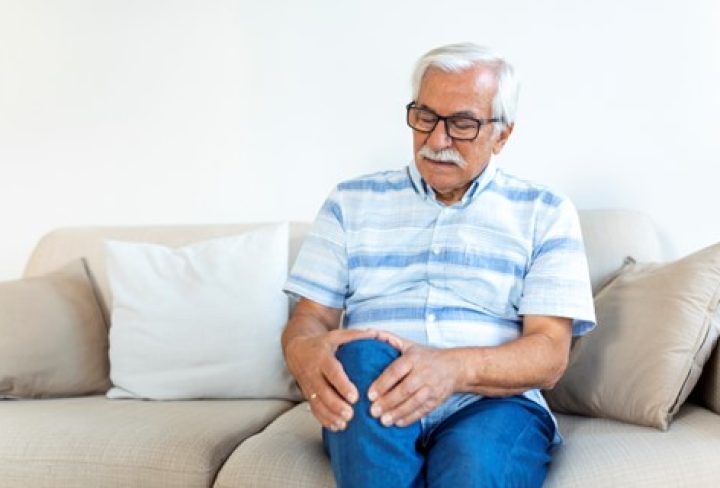Osteoarthritis of the knee (degenerative joint disease) results from wear and tear when cartilage (a strong, flexible connective tissue that protects the joints and bones) in the knee joint breaks down. Due to the loss of cartilage, the knee joint bones rub together, causing friction that hurts the knees, causing stiffness and swelling.
It is a painful chronic joint disorder and is more common in older adults. The intensity of the symptoms varies for each person and usually progresses slowly.
Osteoarthritis of the knee is very common, and about 46% of people develop it during their lifetime.
What are the clinical symptoms of Knee Osteoarthritis?
- Knee pain that worsens with activity
- Joint stiffness
- Joint swelling
- Pain after prolonged sitting or resting
- Cracking or grinding sound on movement
- Feeling of warmth or redness
- Deformity of the joint
- Feeling the knee may “give out”
What are the possible causes of Knee Osteoarthritis?
Knee Osteoarthritis could be either primary or secondary, depending on its cause:
Primary Knee Osteoarthritis is cartilage degeneration without any known reason and could be due to age or wear and tear.
Secondary Knee Osteoarthritis is cartilage degeneration due to a known reason which could be:
- Obesity
- More joint flexibility or instability
- Malposition of the joint
- Previous injury to the joint
- Congenital defects (birth defects)
- Immobilization and reduced mobility
- Underlying medical conditions like rickets
- Family history
What are the possible risk factors?
The primary risk factor for knee osteoarthritis is age. Other factors which increase the risk of developing arthritis include:
- Increased body weight: An increase in weight increases pressure on all the joints, especially the knees
- Heredity: Genetic mutations or inherited abnormalities in the shape of the bones that surround the knee joint increase the risk of the disease
- Gender: Women (aged 55 and older) are more likely to develop osteoarthritis of the knee than men
- Repetitive stress injuries: People with occupations that include a lot of activity, such as kneeling or lifting heavy weights, cause constant pressure on the joint and are more likely to develop osteoarthritis of the knee
- Athletics: Athletes such as soccer, tennis, or long-distance running may be at higher risk for knee osteoarthritis.
- Other underlying conditions: People with rheumatoid arthritis and certain metabolic disorders like iron overload or excess growth hormone are at a higher risk of knee osteoarthritis.
How Is Knee Osteoarthritis Diagnosed?
- The diagnosis begins with a physical examination of the knee.
- Inform the doctor if the pain is worse to help determine the cause of the pain. Further investigations include:
- X-rays: To check the bone and cartilage damage and the presence of bone spurs
- Magnetic resonance imaging (MRI) scans: MRI scans may be ordered when X-rays do not give a clear reason for joint pain or when X-rays suggest any damage.
- The doctor may also recommend blood tests to rule out other conditions causing the pain.
What are the Treatment Options for Knee Osteoarthritis?
The primary goal of treating knee osteoarthritis is to relieve pain and return mobility. The treatment options include:
- Weight loss: Losing weight can significantly decrease knee pain from osteoarthritis.
- Exercise: Stretching and other strengthening exercises help keep the knee joints more stable and decrease pain.
- Pain relievers and anti-inflammatory drugs: The doctor may prescribe certain anti-inflammatory or other medication to help ease the pain.
- Corticosteroid or hyaluronic acid injections for the knees: Hyaluronic acid, which is normally present in joints as a lubricating fluid and steroids are powerful drugs used to ease the pain.
- Alternative therapies: Topical creams or supplements can help decrease knee pain from osteoarthritis.
- Using devices like braces: The doctor may recommend braces that provide support to the knees.
- Physical and occupational therapy: This helps you with your daily activities and can help strengthen muscles and increase flexibility in the joint.
- Surgery: The doctor may recommend surgery when other treatments do not work.
- Surgical options include:
- Arthroscopy: A procedure used to remove damaged cartilage, clean the bone surface, and repair other types of tissues.
- Osteotomy: A procedure used to improve knee alignment by changing the bones’ shape.
- Joint replacement surgery (arthroplasty): A procedure in which joints are replaced with artificial parts made of metals or plastic.
How to prevent osteoarthritis of the knee?
Preventing knee osteoarthritis is challenging; however, you can reduce the risk of developing the condition by:
- Maintain a healthy weight
- Reduce stress or pressure on your knees
- Walking or jogging on smooth surfaces
- Perform low-impact exercises
- Take supplements (adding omega-3 fatty acids with the doctor’s advice)
- Choose proper footwear (avoiding heels)
- Avoid lifting heavy objects
5 Best Exercises to Reduce Knee Pain-
- Clamshells
- Bridging
- Hip Abduction
- Straight Leg Raise
- Quadruped Hydrant
RICE formula for knee pain:
Rest for a day or two to heal
Ice your knee to calm inflammation
Compress (wrap) your joint to stop fluid buildup
Elevate your legs on a pillow or stool to curb swelling
Dos and Don’ts for Osteoarthritis knee Pain
Dos
- Do visit the doctor if joint pain worsens on activity
- Do add more nutrients and supplements to your diet
- Do knee joint-friendly exercises
- Do try braces (with the doctor’s advice)
Don’ts
- Do not rest too much
- Do not overlook your weight
- Do not use heels
- Do not sit on the ground
- Do not lift heavy objects


